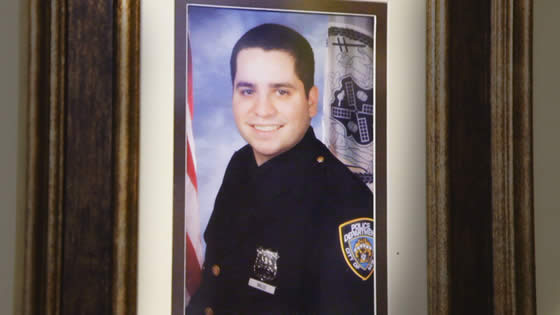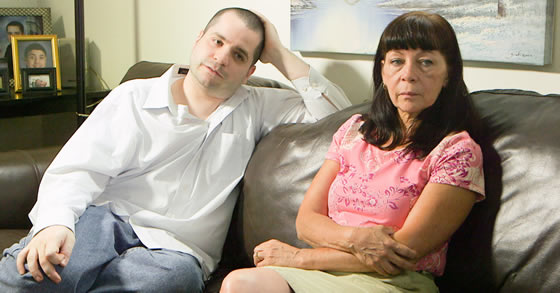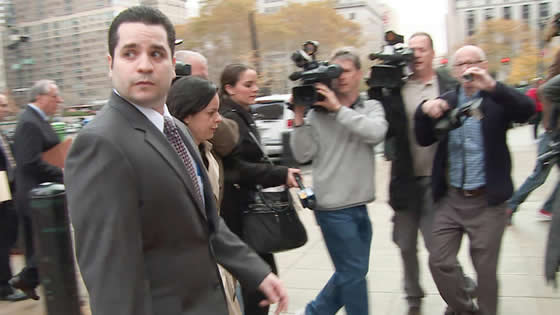 Director Erin Lee Carr’s impressive feature debut Thought Crimes: The Case of the Cannibal Cop is the first-hand account of the NYPD’s “Cannibal Cop.” Carr takes on the well-known tabloid story of Gilberto Valle, the man charged with conspiracy to kidnap and eat women, and elevates it into a terrific documentary and debate on guilt vs. innocence in the tech era.
Director Erin Lee Carr’s impressive feature debut Thought Crimes: The Case of the Cannibal Cop is the first-hand account of the NYPD’s “Cannibal Cop.” Carr takes on the well-known tabloid story of Gilberto Valle, the man charged with conspiracy to kidnap and eat women, and elevates it into a terrific documentary and debate on guilt vs. innocence in the tech era.
Dubbed “The Cannibal Cop,” Valle was convicted in March 2013 of conspiring to kidnap and eat young women. Valle argued it was all a fantasy; the prosecution’s narrative convinced jurors otherwise. Valle was facing a possible life sentence when filmmaker Erin Lee Carr began visiting him in prison. After 22 months behind bars, his conviction was overturned in a stunning reversal. Carr was there for his release and subsequent house arrest to examine a life arrested. But the question remains: given the chance, would he, could he, have done it? THOUGHT CRIMES unravels the conflicting stories of a potentially dangerous young man and the unexpected consequences of our online activity.
Bijan Tehrani: What motivated you to make THOUGHT CRIMES: THE CASE OF THE CANNIBAL COP?
Erin Lee Carr: I read about it and saw on the tabloids online, on sites like Gawker and slate and immediately felt drawn to the story. It was a very scary story about a police officer that was having horrifying thoughts and was discussing kidnapping and raping and eating women. I just had never heard anything like that so I kept going back to it and asking people about it and then I put it in a document and kept those ideas that interested me. When I was speaking with HBO about a project to make, they asked me what I was interested in, and the case of the cannibal cop came up to me.
Bijan: What’s interesting about your approach is that you are not taking any sides in the story, and this helps the audience come up with their own verdict about this story. Was this deliberate?
Erin Lee Carr: Yes it was intentional. A lot of the films I really love and care about like “Capture the Freidmans”, in which Andrew Jarecki directed, have this approach. Watching that film, I didn’t know how he felt about the family. Of course there are certain hints in the film, but I think that one of the reasons that film stayed with me for so long was because of the salacious nature of the case. It was a legal drama, but also because I did not know how to feel about the family and the father. Therefore when discussing our approach to THE CANNIBAL COP with my editor, our goal became to keep this as balanced as possible and not to take a side. It was really important for the audience to decide.
Bijan: Alfred Hitchcock says that a door that is half closed is scarier than a 100 corpses. I think something about this movie that is very scary is that there is no one killed but it is still a scary situation, and you develop that really well.
Erin Lee Carr: The chats in the film and the graphic treatment of them allows our imagination to run away with us, and that is a part of the scary aspect of the case—what happens when each of us close our eyes at night?
Bijan: One thing that was amazing for me was the ability to get the trust of Gil and his mother. How did you manage to do that?
Erin Lee Carr: I think Gil and his mom had stayed silent for a long time. I didn’t want to ever speak for them, but I think at a certain point it was time to see how Gil felt about the case and how he felt about the trial. HBO presented him with an opportunity to be able to talk about what had happened, and you will see that the longer you do it, the more comfortable a subject will get. I am grateful to HBO that they gave the time to be able to do this film in the right way.
 Bijan: How did you come up with the visual style of your film?
Bijan: How did you come up with the visual style of your film?
Erin Lee Carr: I mentioned the editor, and he really took a lot of the reigns as it came to the visual component. I was in charge of the story and getting all of the interviews and getting us the material that we needed, but because I was so close to getting HBO in the family, it was important to have someone who did not have the interpersonal dynamic. So one day I came into the office and Andrew wanted me to look at courtroom sketches, and he had literally—in After Effects—created a 3-dimensional space, bringing out the characters in the film. It was just something I had never thought of doing, and it was in large credit to his creativity and his ability to see the story in the grander scale.
Bijan: Have Gil and his mom seen the finished film?
Erin Lee Carr: Gil and his legal team saw the film before it premiered at Tribeca. His mother has not seen the film. Gil, at some point, will speak about what he thought about the film, but I do not want to speak for him.
Bijan: Tell us how you felt when you were with the audience in the theater at Tribeca?
Erin Lee Carr: It was a very fun experience! I thought I would be more nervous watching the film with an audience but I think it felt really natural and I think it felt cinematic. It was an incredible gift to be able to watch it with an audience and be able to premiere it at Tribeca. I sat near Andrew, and people laughed a lot more than I thought they would—it was incredible and very interesting.
Bijan: What is the next project that you are working on?
Erin Lee Carr: I am working, in typical fashion, on a documentary with HBO about the Internet and I would love to find a story similar to this one; involving the ramifications of online behavior in a meaningful way.

